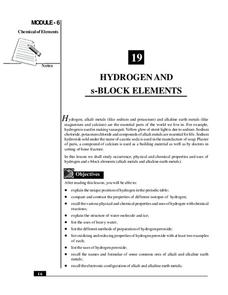PBS
Untangling the Devil's Corkscrew
How did scientists unravel the mystery of an ancient beaver species? An engaging video from a well-written biology playlist discusses the discovery of strange spiral fossils found in Nebraska farm country. Junior paleontologists examine...
Curated OER
The Martian Chronicles: Concept Analysis
If you're planning on including Ray Bradbury's The Martian Chronicles in your science fiction unit, use a concept analysis guide to frame your instruction. It covers literary elements such as setting, narrative voice, and theme, as well...
Stated Clearly
What is DNA and How Does it Work?
Discussions of DNA occur in Jurassic Park, X-men, Dexter, and CSI, yet many don't fully understand it. The video explains what DNA is, where it is located, and how it forms proteins. The chemistry of life becomes understandable through...
The Brain Scoop
Dissecting Ants
Scientists study the gut bacteria in ants to better understand their digestive process. Brain Scoop presents the proper way to dissect ants as part of their Insects playlist. The video shows the steps and explains why each is necessary...
Curated OER
Phase Diagrams
In his previous videos, Sal shows students how to calculate how much energy is needed to change various amounts of water from state to state when the atmospheric pressure is constant. In this video, he shows students how to use phase...
Howard Hughes Medical Institute
Great Transitions: The Origin of Tetrapods
The featured movie focuses on the ancestry of our four-footed friends. Find the fundamental pattern of their limbs and vertebrae in fossils of fish. After viewing, biology learners can enjoy interactive websites to zoom in on the...
Penn Museum
Penn Museum: China Gallery
Invite your learners to take a closer look at the art and mathematical function of dome buildings as designed by the ancient Romans. In the next segment of this attractive learning exercise set, your young historians will then learn...
National Institute of Open Schooling
Hydrogen and s-Block Elements
Lesson 19 in the series of 36 analyzes the element hydrogen and the s-block elements. Through readings, answering questions, and discussion, learners write about and explain their occurrence, physical and chemical properties, and uses.
Kurzgesagt – In a Nutshell
Space Elevator – Science Fiction or the Future of Mankind?
In 1895, Konstantin Tiolkovsky proposed the concept of a space elevator. It's now over 100 years later and scientists working toward the concept still aren't sure it is possible. The video explains the concept, the benefit, and the many...
Curated OER
Teaching About Plate Tectonics and Faulting Using Foam Models
Young scientists learn about plate tectonics and the three different types of faults (normal, reverse, and strike-slip) using foam models. The activity also covers common types of locations where these faults are found.
Crash Course
Taxonomy: Life's Filing System
Explore the history of taxonomy, the naming of organisms, with a video about Linnaeus and his classification system that is still used by scientists today to show the evolutionary relationships among organisms.
McGraw Hill
Arthropods
Are spiders related to crabs? Study the order of arthropods with a reading selection about animal diversity. It provides details about each class within the order, as well as vivid pictures and explanatory charts.
MinuteEarth
Why Is All Sand the Same?
We find sand on beaches, sand dunes, timers, and in hydraulic fracturing, but what exactly is it? The video discusses the mineral that composes the majority of sand on the planet. It also explains how it forms and why it ends up near...
MENSA Education & Research Foundation
The Writer’s Toolbox: What You Need to Master the Craft
Strengthen your high schoolers' writing with a series of steps for writing successfully. With sections on organizing an essay, choosing a topic, crafting a thesis statement, and revising a draft, the lesson encourages your class to...
NASA
Heavy Lifting
Astronauts need a way to lift heavy objects. Pupils design and build a crane out of cardboard and determine ways to improve their cranes based upon the outcomes of testing.
Rensselaer Polytechnic Institute
Molecules to the Max!—Teacher's Discovery Guide
Molecules to the Max! refers to a movie released in 2009 about the world of atoms and molecules. A helpful discovery guide provides five posters on science topics typically covered at the middle school level. It also explains the...
Other popular searches
- Structure of the Earth
- Earth Structure Mantle Core
- Structure of Earth
- Earth Structure Model
- Science Earth Structure
- Geography Earth Structure
- Earth Structure Video
- Earth Structure 5th
- Earth Structure Scale
- Internal Structure of Earth
- Earth Structure Worksheets

















